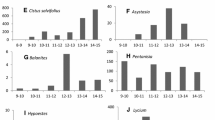Summary
Annual flower production ranged over four orders of magnitude among individuals of the tropical tree Prockia crucis (Flacourtiaceae), but the number of visits per flower by bees did not increase with flower number. In a population in Jalisco, México, the trees flower for about one week each year, offering only pollen to the bees (mostly solitary species). In a small group of trees, the number of visits per flower was less on trees with greater flower production but in a large group visitation did not vary between trees. Pollen flow probably was not directed from large to small trees or vice versa, because the number of flowers per tree did not determine the schedule of visits. The ratio of pollinators to pollen thieves decreased rapidly through the day, while individuals of both groups foraged more rapidly. Most bee species were rare, and only a small subset of medium-sized to large bees were effective pollinators. Large and small groups of trees differed in the relationship between individual flower crop and abundance and diversity of both pollinators and thieves.
Similar content being viewed by others
References
Armesto JJ, Mitchell JD, Villagren C (1986) A comparison of spatial patterns of trees in some tropical and temperate forests. Biotropica 18:1–11
Arroyo MTK (1976) Geitonogamy in animal-pollinated tropical angiosperms: a stimulus for the evolution of self-incompatibility. Taxon 25:543–548
Augspurger CK (1980) Mass flowering of a tropical shrub (Hybanthus prunifolius): influence on pollinator attraction and movement. Evolution 34:475–488
Baker HG, Cruden RW, Baker I (1971) Minor parasitism in pollination biology and its community function: the case of Ceiba acuminata. Bioscience 21:1127–1129
Bawa KS (1974) Breeding systems of tree species in a tropical lowland community. Evolution 28:85–92
Bawa KS, Opler PA (1975) Dioecism in tropical forest trees. Evolution 29:167–179
Bawa KS, Bullock SH, Perry DR, Coville RE, Grayum MH (1985) Reproductive biology of tropical lowland rain forest trees. II. Pollination systems. Am J Bot 72:346–356
Bullock SH (1983) Population structure and reproduction in the neotropical dioecious tree Compsoneura sprucei. Oecologia 55:238–242
Bullock SH (1985) Breeding systems in the flora of a tropical deciduous forest in México. Biotropical 17:287–301
Bullock SH (1986a) Climate of Chamela, Jalisco, and trends in the south coastal region of México. Arch Met Geoph Biocl Ser B 36:297–316
Bullock SH (1986b) Observations and an experiment on synchronous flowering. Madroño 33:223–224
Bullock SH, Domínguez PT CA (1986) Pruebas de limitación de fecundidad por polinizadores en dos árboles tropicales. Brenesia 25/26:197–201
Frankie GW (1975) Tropical forest phenology and pollinator plant coevolution. In: Gilbert LE, Raven PH (eds) Coevolution of Animals and Plants, Univ. Texas Press, Austin, pp 192–209
Frankie GW, Haber WA (1983) Why bees move among massflowering neotropical trees. In: Jones CE, Little RJ (eds) Handbook of Experimental Pollination Biology, Van Nostrand Reinhold Co, New York, pp 360–372
Frankie GW, Opler PA, Bawa KS (1976) Foraging behavior of solitary bees: implications for outcrossing of a neotropical forest tree species. J Ecol 64:1049–1057
Geber MA (1985) The relationship of plant size to self-pollination in Mertensia ciliata. Ecology 66:762–772
Gentry AH (1974) Flowering phenology and diversity in tropical bignoniaceae. Biotropica 6:64–68
Gentry AH (1978) Anti-pollinators for mass-flowering plants? Biotropica 10:68–69
Hallé F, Oldeman RAA, Tomlinson PB (1978) Tropical trees and forests. Springer Berlin Heidelberg New York
Koptur S (1984) Outcrossing and pollinator limitation of fruit set: breeding systems of neotropical Inga trees (Fabaceae: Mimosoideae). Evolution 38:1130–1143
Lott EJ, Bullock SH, Solís-Magallanes JA (1987) Floristic diversity and structure of upland and arroyo forests in coastal Jalisco. Biotropica 19:228–235
Percival M (1974) Floral ecology of coastal scrub in southeast Jamaica. Biotropica 6:104–129
Petersen C, Brown JH, Kodric-Brown A (1982) An experimental study of floral display and fruit set in Chilopsis linearis (Bignoniaceae) Oecologia 55:7–11
Rauscher MD, Fowler NL (1979) Intersexual aggression and nectar defense in Chauliohnathus distinguendus (Coleoptera: Cantharidae). Biotropica 11:96–100
Ruiz Z T, Arroyo MTK (1978) Plant reproductive ecology of a secondary tropical deciduous forest in Venezuela. Biotropica 10:221–230
Schemske DW, Horvitz CC (1984) Variation among floral visitors in pollination ability: a precondition for mutualistic specialization. Science 225:512–521
Spain JD (1982) BASIC microcomputer models in biology. Addison-Wesley, Reading
Standley PC (1923) Trees and shrubs of México (Oxalidaceae-Turneraceae). Contrib U S Nat Herb 23, part 3:517–848
Wyatt R (1982) Inflorescence architecture: how flower number, arrangement, and phenology affect pollination and fruit set. Am J Bot 69:585–594
Author information
Authors and Affiliations
Rights and permissions
About this article
Cite this article
Bullock, S.H., del Rio, C.M. & Ayala, R. Bee visitation rates to trees of Prockia crucis differing in flower number. Oecologia 78, 389–393 (1989). https://doi.org/10.1007/BF00379114
Received:
Issue Date:
DOI: https://doi.org/10.1007/BF00379114




